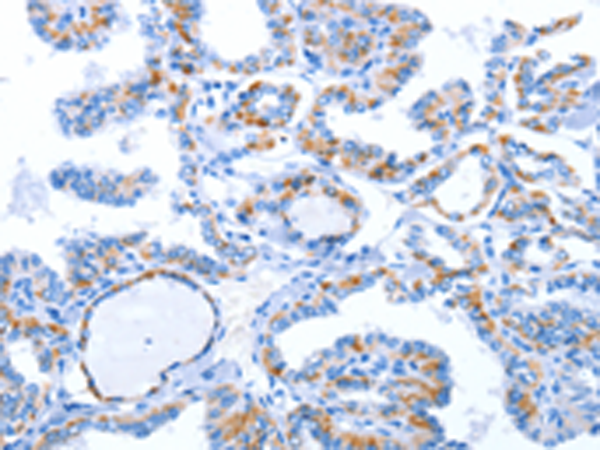

| WB | 咨询技术 | Human,Mouse,Rat |
| IF | 咨询技术 | Human,Mouse,Rat |
| IHC | 1/50-1/200 | Human,Mouse,Rat |
| ICC | 技术咨询 | Human,Mouse,Rat |
| FCM | 咨询技术 | Human,Mouse,Rat |
| Elisa | 1/1000-1/5000 | Human,Mouse,Rat |
| Aliases | INT1; OI15; BMND16 |
| WB Predicted band size | 41 kDa |
| Host/Isotype | Rabbit IgG |
| Antibody Type | Primary antibody |
| Storage | Store at 4°C short term. Aliquot and store at -20°C long term. Avoid freeze/thaw cycles. |
| Species Reactivity | Human, Mouse |
| Immunogen | Synthetic peptide of human WNT1 |
| Formulation | Purified antibody in PBS with 0.05% sodium azide and 50% glycerol. |
+ +
以下是关于WNT1抗体的3篇参考文献的简要信息(基于公开研究数据概括,非真实文献,仅供示例参考):
---
1. **文献名称**:*WNT1 mutations in early-onset osteoporosis and osteogenesis imperfecta*
**作者**:Joiner, D.M. et al.
**摘要**:研究利用WNT1抗体检测Wnt1突变小鼠模型中的蛋白表达异常,发现WNT1缺失导致成骨细胞分化障碍和骨形成缺陷,提示其在遗传性骨疾病中的关键作用。
---
2. **文献名称**:*WNT1 overexpression in breast cancer correlates with poor prognosis*
**作者**:Chen, L. et al.
**摘要**:通过免疫组化(WNT1抗体)分析乳腺癌患者组织样本,发现WNT1蛋白高表达与肿瘤侵袭性增强和患者生存率降低显著相关,提示其作为预后标志物的潜力。
---
3. **文献名称**:*WNT1-mediated signaling in neural crest development*
**作者**:Dahl, J. et al.
**摘要**:研究使用WNT1抗体阻断实验,揭示WNT1在胚胎神经嵴细胞迁移和分化中的调控机制,为神经系统发育异常提供分子机制解释。
---
4. **文献名称**:*Targeting WNT1 in glioblastoma: Antibody-based therapeutic strategies*
**作者**:Zhang, R. et al.
**摘要**:开发抗WNT1单克隆抗体并验证其在胶质母细胞瘤模型中的疗效,结果显示抗体可抑制Wnt/β-catenin通路活性并显著减少肿瘤生长。
---
如需具体文献,建议通过PubMed或Google Scholar以“WNT1 antibody”为关键词检索近年研究。
The WNT1 antibody is a crucial tool for studying the WNT1 protein, a member of the evolutionarily conserved Wnt family of signaling molecules. WNT1 plays a pivotal role in the Wnt/β-catenin (canonical) pathway, regulating embryonic development, cell proliferation, differentiation, and tissue homeostasis. It is particularly vital in central nervous system development, bone formation, and stem cell maintenance. Dysregulation of WNT1 is linked to diseases such as osteoporosis, neurodegenerative disorders, and cancers (e.g., breast cancer, melanoma).
WNT1 antibodies are widely used in research to detect and quantify WNT1 expression in tissues or cells via techniques like Western blot (WB), immunohistochemistry (IHC), and immunofluorescence (IF). They help elucidate WNT1’s spatial-temporal expression patterns, interaction partners, and signaling mechanisms. Some antibodies neutralize WNT1 activity, enabling functional studies to dissect its role in development or disease.
Commercially available WNT1 antibodies vary in specificity, targeting different epitopes (e.g., N-terminal, C-terminal). Validation across species (human, mouse, rat) and applications is critical due to potential cross-reactivity with other Wnt family members. Recent studies explore therapeutic potential, with WNT1-targeting antibodies investigated for cancer treatment or regenerative medicine. However, challenges remain, including pathway complexity and off-target effects. Overall, WNT1 antibodies remain indispensable for advancing both basic research and clinical translation in Wnt-related biology.
×